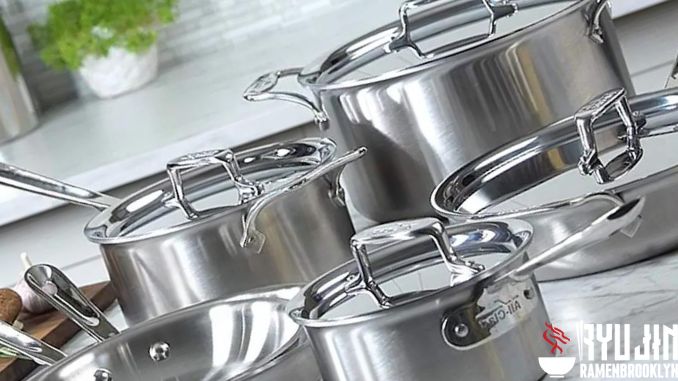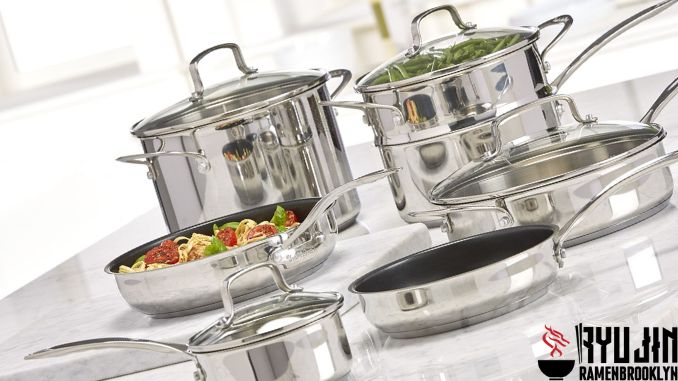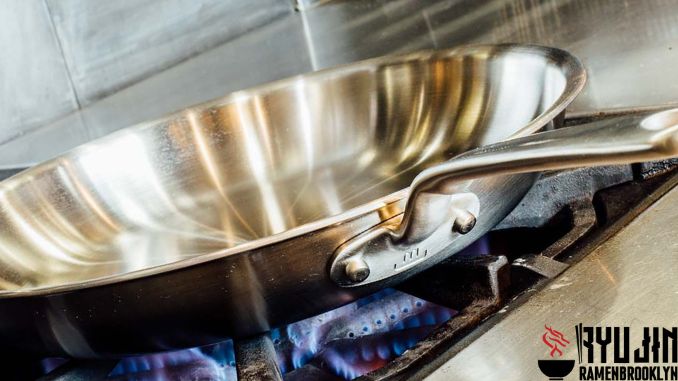How to Buy Stainless Steel Cookware
It’s no secret that stainless steel cookware is a popular choice for kitchens worldwide. Not only does it look great, but it also performs well and is easy to clean. But with so many different brands and types of stainless steel cookware on the market, how can you be sure you’re buying the right one for your needs?
Just as there are different types of stainless steel cookware, there are also different ways to purchase them. This can make the process seem a bit overwhelming, but it can be much easier with the right advice.
This post will outline some tips for finding the best deals on stainless steel pots and pans. We’ll also examine what factors you should consider when choosing this cookware. So whether you’re upgrading your current set or starting, read for some helpful guidance on buying stainless steel cookware.
What is Stainless Steel Cookware?
Steel is an alloy (which means mixture) of mostly iron combined with up to 1.7% by weight carbon. It can be made into different types depending on how many other elements are added: plain old steel has no special properties at all, but if you add in some nickel, then it will become stainless steel which becomes resistant to corrosion because its surface oxygen doesn’t penetrate far enough through the layers of chromium oxide that are formed on the surface Stainless steel cookware is made with a minimum of 10.5% chromium.
This makes it more durable and resistant to corrosion and rust than other cookware. The chromium in the stainless steel also makes it less likely to react with food, which means your food will retain its flavor and nutrients.
There are several grades of stainless steel, but the two most common are 304 and 316. Grade 304 is the most widely used, as it is more affordable and has a lower carbon content. On the other hand, grade 316 is more expensive but is more resistant to corrosion and heat.
The amount of chromium in stainless steel varies according to what it will be used for, e.g., cookware or industrial uses. For food contact, there are standards set by NSF International that require at least 16% weight with chromium and other elements too, like Molybdenum (which makes the metal harder), Nickel & Nitrogen, which give it its signature shine!
Stainless steel contains elements such as Molybdenum, nickel, and nitrogen that give it a shiny appearance. Adding nickel makes food-grade stainless steel stronger and improves its resistance to oxidative corrosion, particularly when exposed to acidic materials. It also gives a ‘silver-like’ shine that can be seen in most kitchen appliances today!
See more: Is Mainstays Stainless Steel Cookware Safe?
How to Buy Stainless Steel Cookware
What should you consider when buying stainless steel cookware? Stated another way, what determines the quality of these items, and how will they affect our food’s taste profile and nutritional value over time? Say hello to all your new kitchen appliances! We know that walking around with calipers or scales isn’t always practical, but here are some telltale signs of high-quality equipment:
The Grade of Stainless Steel: 18/8 or 18/10
The first number is the percentage of chromium in the alloy, and the second number is the percentage of nickel. These are the two elements that make stainless steel so resistant to corrosion.
18% chromium and 8% nickels are Type 304 or austenitic stainless steel. This kind of steel is non-magnetic, tough, and highly resistant to oxidation and heat.
18% chromium and 10% nickel is called Type 316 or austenitic-ferritic stainless steel. This grade of stainless steel has a lower carbon content than Type 304, making it less susceptible to intergranular corrosion. It’s also non-magnetic and can withstand extremely high temperatures.
The Weight of Cookware
High-quality stainless steel cookware is generally heavier than its lower-priced counterparts. This is because higher steel grades are thicker and less likely to warp over time.
Additionally, a good gauge or thickness of stainless steel will conduct heat more evenly, eliminating hotspots so your food doesn’t stick or burn. A heavy pan also distributes heat better by using lower temperatures when cooking, saving energy in the long run.
The Core Material
With stainless steel being such a poor conductor of heat, it’s important to find sets with an aluminum or copper core. This will ensure your set lasts for years while still getting the superior thermal performance you want from these other two metals too! But, of course, you know that a clad pan will always be more expensive than one with just metal.
Stainless steel cookware has been around for a long time and is still one of the most popular choices among avid chefs. The performance that these pans deliver is due, at least in part, to how efficiently they spread heat with no hot spots present – this depends on the thickness of the core material (stainless steel).
A thicker copper/aluminum interior will result in better overall distribution than something like an iron pan because even when covered up by food residue, there won’t be as much thermal contact between layers, so less energy gets wasted trying vainly reach farther into your oven cavity only find out nothing happened!
When deciding between copper and aluminum cores for your cooking pan, it’s important to consider that an aluminum core needs 3 times as much metal to get the same heat distribution. This means if you own a set made with one material or another–the thicker base will affect performance, so make sure they match up accordingly!
Price
Of course, you get what you pay for. So if you want the best quality cookware, be prepared to shell out some serious dough. The good news is that stainless steel cookware is built to last a lifetime, so the initial investment will be worth it in the long run.
Plain stainless steel cookware is a good choice if you’re on a tight budget. But if you can afford it, we recommend investing in clad or coated cookware for the best results.
When looking at different sets of stainless steel cookware, keep an eye out for sales and special offers. You might be able to snag a great set at a fraction of the cost!
The Reputation of the Company
There are many different brands of stainless steel cookware on the market. Naturally, some are better than others. When choosing a set, it’s important to do your research and read reviews from other customers. You should also look for a company that offers a product warranty. This shows that they’re confident in the quality of their cookware and are willing to stand behind it.
See more: How to Clean Zwilling Cookware
FAQs about Stainless Steel Cookware
The first stainless steel was created in 1913 by an arm chemist trying to make stronger materials for weapons. It’s now used throughout our lives- from cookware and appliances, building construction, or even implants!
But if you’re looking into buying new kitchen gear made of this durable metal (or just want answers on what type would best suit your needs), some things might surprise/amuse seasoned users:
What Does “Stainless” Mean?
Stainless steel is an alloy of several different metals, including chromium, nickel, and Molybdenum. This combination creates a material that is resistant to staining and corrosion.
Why Doesn’t Everything Have a Shiny Finish Anymore?
The term “stainless” refers to the fact that this metal is not easily eroded by water or air. However, exposure to certain substances can cause stainless steel to discolor or stain over time.
Why Isn’t My Old Set Holding Up Well Despite Being “Stainless”?
One reason your old set might not perform as well as it used to is that it’s made of lower-quality stainless steel. Another possibility is that it hasn’t been properly cared for and has developed tarnish or rust.
How Do I Know If It’s Good Quality Stainless Steel Cookware?
When shopping for new stainless steel cookware, look for high-quality 304 or 316-grade stainless steel pieces. These grades are less likely to rust or tarnish over time.
What are The Pros and Cons of Each Type of Stainless Steel Cookware?
There are three main types of stainless steel cookware on the market:
-Clad: This cookware has a layer of stainless steel bonded to an aluminum or copper core. Clad cookware is known for its even heat distribution and superior cooking performance.
-Coated: Coated stainless steel cookware has a non-stick surface, making it ideal for low-fat cooking.
-Plain: Plain stainless steel cookware is the most basic type on the market. It’s less expensive than other types but doesn’t offer the same cooking performance or durability.
When choosing stainless steel cookware, you must consider your needs and budget. Clad and coated cookware is more expensive than plain stainless steel but offers better cooking performance and durability. Plain stainless steel cookware is a good choice if you’re on a tight budget. But if you can afford it, we recommend investing in clad or coated cookware for the best results.
See more: How to Season a Stainless Steel Pan
Final Thoughts
Stainless steel cookware is a great choice for any kitchen. It’s durable, easy to care for, and it looks good too! When choosing a set, consider the company’s weight, core material, price, and reputation. With so many different sets on the market, you’re sure to find one perfect for your needs.
You know how to buy stainless steel cookware, so get out there and start shopping! You’ll be cooking like a pro in no time. If you have any questions, feel free to ask in the comments below. And be sure to check out our other buyer’s guides for more great kitchen tips and tricks.
Anthony Michelin (March 26, 1960) is the CEO of Ryujinramenbrooklyn.com – is an expert in finding specialized equipment to assist in the Bar & Kitchen sector. With over 40 years of focus on finding the simplest recipes on the most suitable cookware to create the most delicious meals, I believe it will help you.



